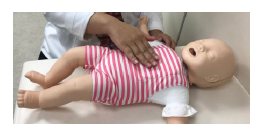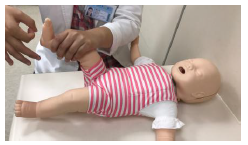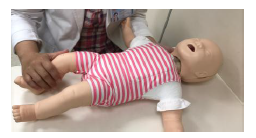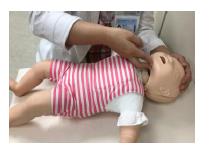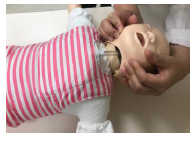Cardiopulmonary arrest is most common in premature infants, such as spontaneous apnea, choking on milk, airway obstruction caused by accidental or suspected ingestion of jelly or buttons. The primary life-saving operation for infants is to keep the airway open, which can restore the heartbeat and blood circulation in most babies.
Basic CPR steps for infants
-
When it is found that the baby's face turns white, black and has poor mobility:
|
Step 1: Pat the baby's chest first to see if it responds. |
|
|
Step 2: Flick the baby's heel to make it cry.
|
|
|
Step 3: Place the baby on a hard table or bed before an ambulance arrives. |
|
|
Step 4: Open the baby's respiratory tract to keep it unobstructed: 1.Head-tilt/chin-lift Place one hand giving pressure on the forehead and the other on the chin. Lift the chin up (if the neck is injured, do not use this method). 2.Jaw-thrust (Suspected neck or spinal cord injury in the baby) Place both hands on the chin corners of the baby. Lift the chin up with the strength of your hands and open the mouth. |
|
- If the chest does not rise and fall, check whether there is any foreign body blocking the baby's mouth. If any, remove the foreign body with fingers first, and carry out the following treatment:
Treatment of foreign body obstruction
|
Step 1: Remove foreign bodies Move your baby's tongue and chin, and use your index finger to remove foreign objects from your baby's mouth or throat. |
 |
|
Step 2: Pat the back Support the baby's chin, neck and chest with the right palm, making its body incline downward with face down, and hit 5 times with the heel of your left hand in the middle of the scapula. |
 |
|
Step 3: Turn to lying on the back Support the back of the baby's head with your left palm, place it between your arms to avoid shaking, and turn it into a supine position. |
 |
|
Step 4: Press the chest Let the baby lies on your left hand, with its head down and feet up, pressing the lower half of the sternum with two fingers of your right hand, pressing its chest 5 times quickly. |
 |
|
Step 5: Assess breathing See if the baby’s chest is rising and falling, hold your ears close to its nose and mouth, listening and feeling if it is breathing. |
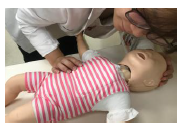 |
|
Step 6: When you find that the baby is not breathing, cover the baby's mouth and nose with a mask, and blow 2 breaths (each breath takes 1 seconds, use the corner of your eye to see the rise and fall of the baby's chest, and then blow the second breath after its chest falls completely). |
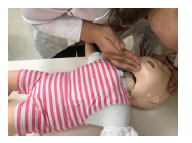 |
|
Step 7:
|
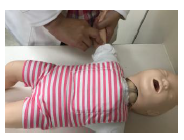 |
|
Step 8: If the baby has no pulse or spontaneous breathing, start cardiac massage immediately:
|
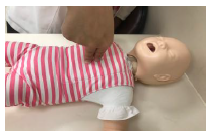 |


